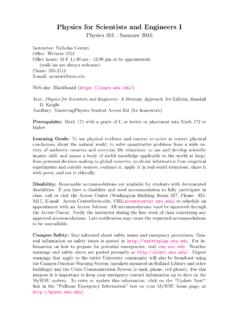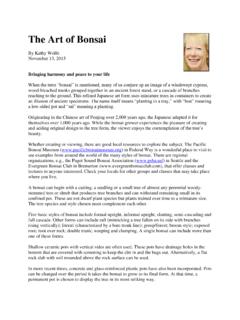Transcription of Wine Basics From grapes to Glass - Washington State University
1 Wine Basics From grapes to Glass Claudia Steen Definitions Viticulture The science and business of growing wine grapes Vigneron - Cultivator of grape vines / wine maker Vitis vinifera wine grape (Genus/species) Enology The science of wine production Enologist (vintner) - wine maker Enophile - someone who enjoys wine History of wine Earliest wine 8000 BC in Mesopotamia 2500 BC - Egyptians Greek & Romans worshiped a god of wine Bacchus Roman Dionysus - Greek Wine is referred to in the Bible Middle Ages - monks took the ancients' knowledge of winemaking and refined it History of WA wine grapes First vines planted in WA State in 1825 Fort Vancouver Hudson Bay Co. 1860 in Walla Walla Dr.
2 Walter Clore father of Washington wine 2014 statistics WA Wine Commission 50,000 acres in production 40 + varieties planted 350 grape growers 227,000 tons of grapes harvested 890 + wineries 16 million cases of wine produced billion dollar industry 53% white wines 47% red wines Health Benefits of Wine Wine, in moderation, is a health benefit: decreased incident of heart attacks & strokes (the French paradox) reduce tumors block formation of amyloidal plaques which contribute to Alzheimer's better dental health, etc Flavonoids - Anthocyanin in grape skin give red color decreases cholesterol Rich in antioxidants Health Benefits of Wine Resveratrol a class of antioxidants known as polyphenols Found in tannins in grape skin, seeds, stems Is produced by plants to ward off fungal infections and other diseases WINE IS MADE IN THE VINEYARD Wine grape growing primarily between 30-50 degrees latitude 50 degree - cool climate wine characteristics 6-7 months to ripen, acid, sugar (alcohol)
3 , lighter color, not as fruit forward, more delicate body 30 degree - warm climate wine characteristics 4-5 months to ripen, acid, sugar, deeper color ( skin to pulp ratio), fuller body, more fruit forward Areas of the World with highest wine production USA production #1 California #2 Washington #3 New York Terroir Sense of place French for terre land Influenced by: geography geology (soil type) Mosel region - blue slate Champagne region limestone Yakima Valley Missoula floods climate (water, sunlight, temperature) plant genetics microclimates Appellations Unique growing regions Old World - Europe & Mediterranean can have mineral notes Burgundy, Loire, Champagne, Bordeaux in France wines often labeled by region Chablis = Chardonnay Chianti = Sangiovese Sancerre = Sauvignon Blanc New World - All other areas (green) S A (Chile, Argentina), South Africa, America (CA, WA, OR, NY)
4 , Australia, NZ wines often labeled by the grape varietal Cabernet, Chardonnay, Riesling Appellations AVA - American Viticulture Area WA State has 13 appellations Yakima Valley - 1983 Walla Walla Valley - 1984 Columbia Valley 1984 Puget Sound - 1995 Red Mountain - 2001 Columbia Gorge 2004 Horse Heaven Hills - 2005 Wahluke Slope - 2006 Rattlesnake Hills - 2006 Snipes Mountain - 2009 Lake Chelan - 2009 Naches Heights - 2011 Ancient Lakes - 2012 In the Vineyard Grape harvest Picked when grapes ripe approximately 24 brix of sugar Read in refractometer (hydrometer) measures total solids in a solution Glucose or fructose plus yeast converts to ethanol plus carbon dioxide during fermentation C6H12O6 + yeast = 2 CH3CH2OH + 2 CO2 2 brix = 1% sugar = 1% alcohol In the Vineyard Acids Picked when grape pH is approximately - found in the grape berry pulp Other indicators of ripeness Leaves turn brown and photosynthesis slows or stops Seeds inside go from green tinge to brown Squeeze berry, pulp is juicy & tastes good!
5 Lab report on must Acids - gives wine body and structure Titratable acidity (TA) pH L - Malic acid - harsher acid Tartaric acid - the principal acid in grapes promotes flavor and aging in wine Lactic acid - softer acid Harvesting the grapes Can be hand picked or machine picked Snips remove grape cluster to bucket Place full buckets into bins At the Winery Bins transported to the winery grapes loaded into stemmer / crusher Stems are removed and discarded White wine Juice is pressed away from the skin & seeds Juice goes into stainless steel fermentation tanks Rose' wine Often use red grapes Juice is pressed away from the skin & seeds Imparts a pink color and then treated like white wine At the Winery Juice with skin and
6 Seeds is called "must Red wine Must goes into large vats for initial fermentation Yeast (Saccharomyces cervisiae) is added Cover with cloth (to keep out fruit flies) Punch down cap daily (skins float - seeds (pips) go to the bottom) Smell is wonderful! Types of Wine Still Cabernet King of wine Chardonnay Queen of wine Sparkling Champagne - France Cava - Spain Proseco - Italy Fortified (brandy) Port Ruby, Vintage, Tawny Sherry Wine grape Varieties Noble grapes most popular, grown worldwide Whites Riesling Sauvignon blanc Chardonnay Reds Pinot Noir Merlot Cabernet Sauvignon Syrah (Shiraz) Many other varieties Wine Production Red wine After initial fermentation the wine is pressed off skin & seeds Can have secondary malolactic (ML) fermentation (Lactobacillus bacteria)
7 The harsher malic acid is changed to the softer lactic acid One bi-product is Diacetyl which gives a buttery flavor and enhances complexity Placed into Oak barrels or maturation tanks Budding in the spring Wine Production White or Rose wine Continue fermentation in cooled stainless steel tanks Fermentation changes sugar to alcohol White/Rose wines - can stop fermentation process if residual sugar desired or zero if dry Red wines often fermented to zero sugar Maturation Process Racking over Take wine off the top and place into another vessel - leaving the "lees" or sediment (dead yeast, seeds, grape solids) Most reds (some whites) put into Oak barrels for barrel maturation Coopers cut oak staves and construct barrel Toasting (carmelization) of the wood imparts flavors to the wine Barrel flavors only lasts 2-3 years Vanillin (phenolic aldehyde) C8H8O3 Lactones (coconut)
8 Phenols a perceived sweetness Spice notes, Leather, few tannins Barrels are toasted Can choose degree of toasting Light - LT Med MT Heavy HT Now can get oak chips to add to wine in neutral barrels Maturation Process Types of Oak American Oak - $$ stronger flavors French Oak - $$$$ tighter grain, better quality Hungarian Oak - $ not as strong flavors as American Neutral Oak used in primary fermentation or maturation where little oak is required Topping off Oak is porous and water evaporates need to add wine to head space to discourage oxidation Wine ready for bottling Filtering in order to clarify wine Fining done with White wine egg whites capture solids White/Rose often consumed within 2-3 years (exceptions -Chardonnay, Sauvignon blanc, etc) Reds often aged before consuming Controversy to fine Reds red wine is often opaque, especially in thick skin grapes (Cabernet, Merlot)
9 Many feel it will remove texture & structure Types of bottles Bordeaux - shoulders Burgandy - slopped sides Rhine (hock) - tapered Others bocksbeutel Specialty bottles Champagne - thick Glass /special stopper Dessert wines - sweet often in splits Fortified wines - Port Colors of Glass Glass colors varies White/Rose wines in clear, light green, yellow green, blue Reds in dark green, brown Important to shield from the light Why is there a Punt at the bottom of the bottle? Necessary when they were hand blown Traps the sediment Provides a more stable base No need - some bottles have no punt Types of closures Cork industry standard BUT decreased supply of cork trees from Portugal - increased cost composite cork often used cork taint from low quality cork oxidized wine from cork failure Synthetic cork seems to not have any issues Twist top - screw cap primarily used for whites/rose that are consumed young, fruit forward Also now for reds - important to keep oxygen out of the bottle Composite Cork plug How do you know a bottle has been oxidized?
10 White wines take on deeper yellow color Red wines take on brownish color Can smell volatile acidity (acetone) VA Cork taint - dirty socks/wet dog smell Cork tree pesticides or chlorine bleach residue (so now use peroxide) Corky mildew TCA trichloroanisole fungi + chlorophenol compounds Wine can taste like vinegar (acetic acid) Life is too short to drink bad wine! Foil placed around top of bottle Helps to keep cork sealed Color is choice of winemaker Wine Labels Label placed on bottle is winemakers choice as to design BUT some mandatory requirements: Must get approval from ATF Vintage Date - Year grapes were picked Name of the winery/contact information Name of the wine varietal Pure varietal - must be 80% by volume to be labeled as such Blended wine nice to State blend percentages Can also make up name of wine Estate Bottled grapes from winery Reserve designation extra aging occurs Net Content 750 ml Wine Labels Any oak information kind, length, toast Appellation of Origin - AVA Vineyard designation (always nice)











